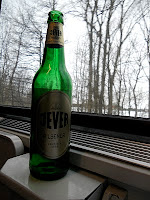The journey to Turkey was a long one. Not literally. Getting to Turkey from Germany is a piece of cake. No doubt a legacy of the hundreds of thousands of Turks who came to Germany as ‘Gastarbeiter’ after World War II. Today, there are large Turkish communities in many German cities and as a result, good airline connections between the two countries. No, the actual trip from Germany to Turkey was easy, short and inexpensive. It was the journey to Turkey that was long.
When I originally made my application for the sabbatical, Turkey was not on the list. My ambition was to visit Iran, to experience life and politics in the muslim country. I knew when I made my list that Iran was going to be something of a stretch. US relations with the Islamic Republic have been bad for decades and took a downturn with Iraq war. Still, when I first made my application we were at the dawn of a new day - maybe. A new presidential administration, maybe things would improve enough to make a visit possible. Or maybe not. In the last year, if anything, things may have become worse. The kidnapping of the UC Berkeley hikers was a barometer for me. In late September, reluctantly, I abandoned the idea.
If not Iran, then what? I think my primary goal in these travels has been to broaden my perspective. Iran could have been replaced with France, or even Canada, but doing that would not further my goals. I began to think about Turkey. MC was enthusiastic about the prospect. Greece and Turkey where on her list the whole time, if only for tourism. The idea got another nudge from Murat, a former student of mine at DVC. “Why not include Turkey in your project,” he said.
Indeed, why not? Well, changing the plan required the approval of the Sabbatical Leave Committee, so I wrote and got that. Turkey would give me a perspective on life in a country that just happens to be muslim (you have to be careful about how you phrase it. More on that in the religion post.)
Playing Wit? There's a new clue. BTW, if you guessed, you are wrong.
When I originally made my application for the sabbatical, Turkey was not on the list. My ambition was to visit Iran, to experience life and politics in the muslim country. I knew when I made my list that Iran was going to be something of a stretch. US relations with the Islamic Republic have been bad for decades and took a downturn with Iraq war. Still, when I first made my application we were at the dawn of a new day - maybe. A new presidential administration, maybe things would improve enough to make a visit possible. Or maybe not. In the last year, if anything, things may have become worse. The kidnapping of the UC Berkeley hikers was a barometer for me. In late September, reluctantly, I abandoned the idea.
 |
| A Turkish Restaurant - In Berlin |
If not Iran, then what? I think my primary goal in these travels has been to broaden my perspective. Iran could have been replaced with France, or even Canada, but doing that would not further my goals. I began to think about Turkey. MC was enthusiastic about the prospect. Greece and Turkey where on her list the whole time, if only for tourism. The idea got another nudge from Murat, a former student of mine at DVC. “Why not include Turkey in your project,” he said.
Indeed, why not? Well, changing the plan required the approval of the Sabbatical Leave Committee, so I wrote and got that. Turkey would give me a perspective on life in a country that just happens to be muslim (you have to be careful about how you phrase it. More on that in the religion post.)
Playing Wit? There's a new clue. BTW, if you guessed, you are wrong.



















































